Dive Brief:
- The consulting firm Arup released a report on Oct. 11 detailing how organic waste could be used in construction projects to further "close the loop" and develop a more circular economy. The report mentions, for example, using potato peels as a fire-resistant insulating material and sound dampener.
- The report identifies six main areas where organic material can be applied in construction: Interior partitions and finishes, furniture, sound absorption, thermal insulation, carpet and other flooring, and "envelope systems" to seal buildings up, making them more energy efficient.
- Globally, construction is the largest industry where raw materials are used. In the U.K. alone, according to the report, 60% of raw material goes to the construction industry. The report also says that organic waste is six times more valuable in economic terms when used in construction or construction products compared to when it is otherwise disposed of or processed.
Dive Insight:
The report includes a map that shows which types of organic materials could be cultivated for use in construction around different areas of the globe. For example, the U.S. has a steady supply of excess corn, peanuts and cellulose. Surplus product from those farming operations could be used as construction or furniture material. In contrast, China and India are shown to have ready supplies of rice, flax and sugarcane. Different regions produce different waste streams and not every waste stream can be utilized in the same way.
Organic material, while a large segment of many municipal waste streams, is of course not the only type of waste that can be utilized in construction and infrastructure projects. Cigarette butts, among the most common litter in the world, can be used to pave roads. Recycled tire scrap, when added to concrete, has been found to improve the construction material's strength. Plastic has been used in multiple prototypes for construction blocks and easily replaceable road sections.
From innovation contests to government plans, there is a clear and growing global interest in transitioning to a circular economy. In some cases this may still be more challenging than the current linear disposal model, but in the long-term it can have clear economic benefits. Many local governments and industry professionals see the construction sector as a prime place to implement these concepts because of the high volumes of debris it generates. Combining that drive with the growing interest in organic waste diversion could open up all kinds of opportunities.













